For over three decades, sci-fi lovers have anticipated not only a brilliant collection by a fifteen-time Hugo winning editor but also a uniquely insightful “Summation” of genre industry news and analysis. Editor Gardner Dozois diligently chronicled years of declines in physical book and magazine publication and the rise of ebooks and ezines in his indispensable annual surveys, offering a perspective into the publishing business that most readers would otherwise never access. The Year’s Best Science Fiction series provided all that, plus thoughtful selections of shorts, novellas and novelettes originally published in dozens of online and print magazines the year prior. Dozois constantly showcased new writers and frequently highlighted their early work prior to their career ascent. He will be sorely missed.
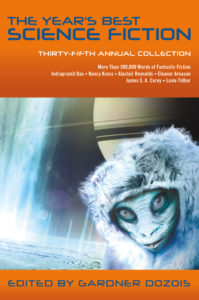 The good news is, other editors like Jonathan Strahan and Neil Clarke have followed Dozois’ format with strong new anthologies of their own. In the meantime, we also have all the man’s prior work to repeatedly enjoy, including his final work — The Year’s Best Fiction, 35th Annual Collection. Here is our review of Dozois’ last installment of “More than 300,000 words of Fantastic Fiction.”
The good news is, other editors like Jonathan Strahan and Neil Clarke have followed Dozois’ format with strong new anthologies of their own. In the meantime, we also have all the man’s prior work to repeatedly enjoy, including his final work — The Year’s Best Fiction, 35th Annual Collection. Here is our review of Dozois’ last installment of “More than 300,000 words of Fantastic Fiction.”
“My English Name” by R.S. Benedict tells the story of an alien that occupies a series of human bodies over the course of several lifetimes. The current body, Thomas Majors, is a polite, well-dressed English teacher in China. Although perhaps not a completely original concept, the story is well crafted with a clear voice and uses the central conceit to show how, at some level, we all experience loneliness, no matter how many chances we have to form lasting relationships.
Rich Larson has two stories in this collection, including “An Evening with Severyn Grimes.” This is a fantastic, Gibsonesque cyberpunk noir with healthy doses of action from start to finish. Although the story serves as hard sci fi escapism, the writing is excellent and brimming with clever near future concepts like the “clamp” (a kind of futuristic neural handcuff), the puppeteers, and a bodyguard named Finch who is augmented with Neanderthal DNA, making him extra tough.
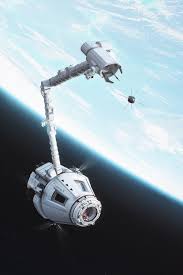
Illustration by Maciej Rebisz
Carter Scholz’s “Vanguard 2.0” presents a possible near future in which the work of astronauts no longer seems so glamorous, consisting mostly of retrieving space junk — defunct satellites and the like — called NSALM (Near Space Logistics and Asset Management) and operated by Uber. A future CEO of Uber, Gideon Price, one of the world’s newly minted trillionaires, makes a surprise visit to the narrator’s NSLAM station with a special request to retrieve Vanguard 1 launched in 1958, the “oldest human thing in space.” The story features nice twists when it turns out Price’s motives are not completely sentimental. We also love stories like “Vanguard” which try to imagine how business and economies might evolve in the future. The story feels like an introduction to a longer piece which we would eagerly read. Illustration by Maciej Rebisz.

Illustration by Victor Mosquera
In “Martian Obelisk,” Linda Nagata writes a beautiful, bleak story about Susannah Li-Langford’s attempt to create something lasting as humanity’s chances for survival dwindle. What distinguishes “Obelisk” from other end-of-the-world stories are the lack of one catastrophic event leading to humanity’s decline and the necessity of hope to survival. Nagata realistically portrays a near future in which a myriad of problems (disease, overpopulation) stack up against humanity; civilization has passed a tipping point, with our best days behind us. The eponymous tower Susannah builds using remotely controlled machines is an attempt to find some meaning in her existence. The final moments of the story bring some glimmer of hope.
With an inventive setting, strong characters, good conflict and exceptionally well written language, Kelly Robson’s “We Who Live in the Heart” stands as one of the strongest entries in the collection. The story takes place aboard a “whale” — a living, floating creature where a handful of industrious women have made their home. The story centers on the arrival of a new crew member, Ricci, recently brought up from the ranks of “moles,” a generic term for the vast majority of the transplanted human population who live underground. The whales of this alien world contain helium, allowing them to float almost indefinitely in the dense atmosphere. The setting is detailed and well thought out, especially the inventive ways the characters have learned to survive. Robson makes great use of contextual language, elevating the story in the ranks of genre writing. “She surfaced quicker than I expected,” states the narrator, a veteran of the sky-faring crew when describing Ricci’s rapid acclimation to life in the whale. Thematically, the story deals with the notions of dependency and whether people are better off depending on each other or in isolation. Tension among the whale crews grows steadily and erupts in a satisfying ending. Bonus: the last section may hint at another chapter in Ricci and her crew living as outlaws. We’d love to see more of this great story.
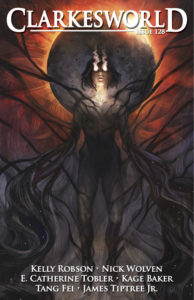
Darkess by Julie Dillon
Alastair Reynolds delivers “Night Passage” — a strong, high concept, swashbuckling yarn loosely set in his expansive Revelation Space universe. A ship captain on a massive light-hugger starship is awoken from “reefersleep” (hibernation) and informed that there’s been a violent mutiny which has nearly marooned them close to an alien object, threatening to destroy the ship in a gravity well. Captain Bernsdottir must match wits against a conjoiner, one of the mutinous passengers who is part of a hive mind, while also trying to save the ship and the rest of the passengers. It’s vintage Reynolds, and no prior familiarity with Revelation Space is needed to enjoy this story, which features surprising twists through the end.
“Waiting Out the End of the World in Patty’s Place Café” is an apt title for Naomi Kritzer’s nice little story about a group of people who come together in an out-of-the-way town hours before an asteroid might hit Earth. The global events are described from the very personal perspective of a few characters trying to find acceptance in what might be their final moments.
“The Hunger After You’re Fed” by the writing duo by The Expanse known as James S.A. Corey is a very short but powerful story about how a near future in which an abundance of food and money won’t solve the most important human need — purpose. The story centers on a character obsessed with meeting a fictional, subversive underground essayist named Hector Prima, who writes, “Those with a ‘why’ to live can bear almost any ‘how’” and describing our world society as a “hedonic treadmill.” This is a brilliantly written story with perhaps not much plot but a whole lot of message to chew on.
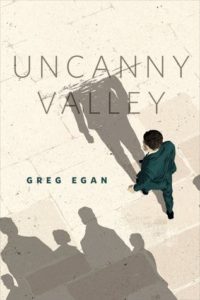
Uncanny Valley, illustrated by Mark Smith
Greg Egan does a nice job of playing out the implications of AI in the near future in the realistically portrayed world of “Uncanny Valley.” The story focuses on the legal status of an AI who is a duplicate of most (but not all) of his patron’s memories, and is trying to find out what biographical information about the old man’s life is being kept from him. Although some of the twists are slightly foreshadowed, the story focuses more on Adam the android’s plight, and he’s so well drawn, it’s hard not to root for him.
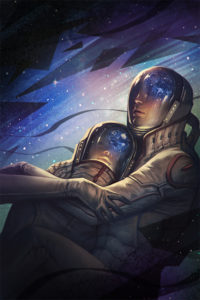
The Worldless, illustration by Reiko Murakami
Indrapramit Das has two stories in this collection, and we loved “The Worldless,” first published in Lightspeed Magazine in March 2017. An achingly beautiful story about two characters barely scratching out a life on an alien space port planet, “Worldless” is beautifully, even poetically written: “When the starship was about to leave, the entire port plain would come alive with warning, klaxons sounding across the miles of empty dirt and clanging across the corrugated roofs of the shop shanties and tents.” The characters are a kind of untouchable class not allowed on the starships despite having come from Earth. Their struggle to survive and possibly return someday to their planet of origin elevates the story to allegory.
Catch the rest of our review of Dozois’ last Years Best SF collection in part 2, coming soon.